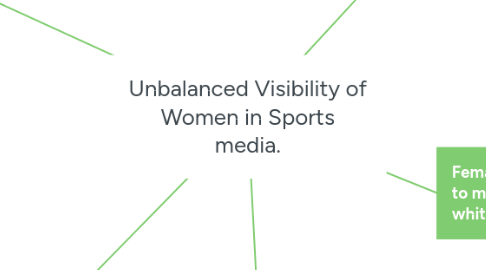
1. Media focusses more on female athlete clothing and appearance rather then their athletic ability or accomplishment
1.1. Marion Jones vs. Amy Acuff
1.1.1. In the 2000 olympics in Sydney, Marion Jones tells reporters that she plans on winning five gold medals. She hardly had any media attention, and won 5 medals. Marion is very strong and muscular, and viewed as unfeminine.
1.1.2. In the 2000 olympics in Sydney, the most photographed athlete was Amy Acuff. Not because she had anticipated winning a lot of medals during the olympics, but because she fit the more feminine stereotype.
1.2. Maria Sharapova
1.2.1. Maria Sharapova receives more attention about her looks than her athletic ability. Commentators hardly report on just Sharapova's athletics, with having a comment on her appearance or what she's wearing.
2. In the media female athletes are very sexualized
2.1. ESPN Magazine
2.1.1. When male athletes are chosen for the cover of ESPN Magazine, they are usually wearing their uniform, looking very powerful. When women are put on the cover of ESPN, they are portrayed in this very sexualized manor, where they is skin showing, or they or feminized.
3. Female sport coverage is not as a popular as male
3.1. Olympics
3.1.1. Male athletes receive more television time, media online, in print and in different magazines. The tune in rates for men's sports compared to female sports. The most played sport for females are, gymnastics, beach volleyball, and swimming, because it's more of a "feminine" type of sport
3.2. NBA VS WNBA air coverage
3.2.1. ESPN divots about 1.4 percent of air time to female sports itself. A centre for feminist research at USC did a study on the media coverage of an WNBA game compared to a NBA game and the ratio falls to a 3.5 to 1. 77.8% of the media covers the NBA while 22.2% covers the WNBA.
4. Females of colour are subjected to more microaggressions then white females
4.1. Micro-aggressions made against Serena Williams vs Angelique Kerber.
4.1.1. Two undergraduate students did a study on how many. Microaggressions were made against female athletes in the 2012 Olympics, in different newspapers and articles. These same two students examined different news stories about tennis players Serena Williams and Angelique Kerber to see if the athletes of colour receive different amounts of microagressions. 758 microaggressions were made against Serena Williams and 18 microaggressions were made against Angelique.
